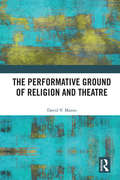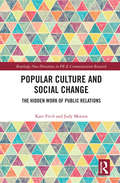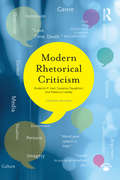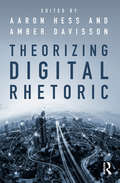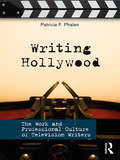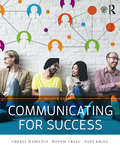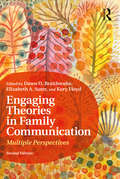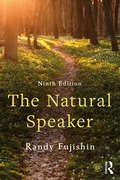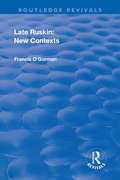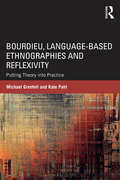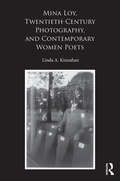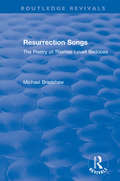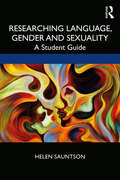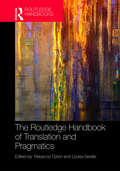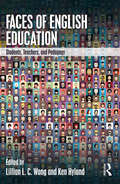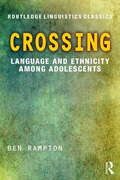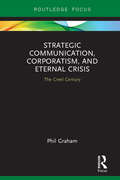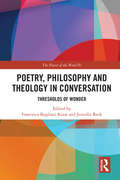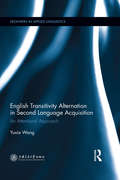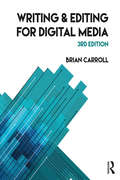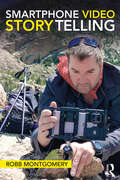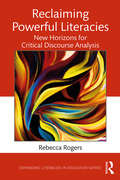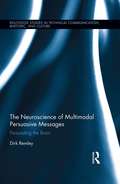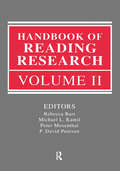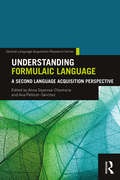- Table View
- List View
The Performative Ground of Religion and Theatre
by David V. MasonReligious practitioners and theatregoers have much in common. So much, in fact, that we can say that religion is often a theatrical phenomenon, and that theatre can be a religious experience. By examining the phenomenology of religion, we can in turn develop a better understanding of the phenomenology of theatre. That is to say, religion can show us the ways in which theatre is not fake. This study explores the overlap of religion and theatre, especially in the crucial area of experience and personal identity. Reconsidering ideas from ancient Greece, premodern India, modern Europe, and the recent century, it argues that religious adherents and theatre audiences are largely, themselves, the mechanisms of their experiences. By examining the development of the philosophy of theatre alongside theories of religious action, this book shows how we need to adjust our views of both. Featuring attention to influential notions from Plato and Aristotle, from the Natyashastra, from Schleiermacher to Sartre, Bourdieu, and Butler, and considering contemporary theories of performance and ritual, this is vital reading for any scholar in religious studies, theatre and performance studies, theology, or philosophy.
Popular Culture and Social Change: The Hidden Work of Public Relations (Routledge New Directions In Public Relations & Communication Ser.)
by Kate Fitch Judy MotionPopular Culture and Social Change: The Hidden Work of Public Relations argues the complicated and contradictory relationship between public relations, popular culture and social change is a neglected theoretical project. Its diverse chapters identify ways in which public relations influences the production of popular culture and how alternative, often community-driven conceptualisations of public relations work can be harnessed for social change and in pursuit of social justice. This book opens up critical scholarship on public relations in that it moves beyond corporate understandings and perspectives to explore alternative and eclectic communicative cultures, in part to consider a more optimistic conceptualisation of public relations as a resource for progressive social change. Fitch and Motion began with an interest in identifying the ways in which public relations both draws on and influences the production of popular culture by creating, promoting and amplifying particular narratives and images. The chapters in this book consider how public relations creates popular cultures that are deeply compromised and commercialised, but at the same time can be harnessed to advocate for social change in supporting, reproducing, challenging or resisting the status quo. Drawing on critical and sociocultural perspectives, this book is an important resource for researchers, educators and students exploring public relations theory, strategic communication and promotional culture. It investigates the entanglement of public relations, popular culture and social change in different social, cultural and political contexts – from fashion and fortune telling to race activism and aesthetic labour – in order to better understand the (often subterranean) societal influence of public relations activity.
Modern Rhetorical Criticism
by Roderick P Hart Suzanne M. Daughton Rebecca LavallyA comprehensive and up-to-date introduction to the analysis of public rhetoric, Modern Rhetorical Criticism teaches readers how to examine and interpret rhetorical situations, ideas, arguments, structure, and style. The text covers a wide range of critical techniques, from cultural and dramatistic analysis to feminist and Marxist approaches. A wealth of original criticism demonstrates how to analyze such diverse forms as junk mail, campaign speeches, and popular entertainment, as well as literature. This long-awaited revision offers specific guidance on crafting analytic essays, and contains new coverage of legacy as well as new media, identity criticism, and post-colonial and decolonial criticism. The fourth edition also offers additional resources online for instructors and students.
Theorizing Digital Rhetoric
by Aaron Hess Amber DavissonTheorizing Digital Rhetoric takes up the intersection of rhetorical theory and digital technology to explore the ways in which rhetoric is challenged by new technologies and how rhetorical theory can illuminate discursive expression in digital contexts. The volume combines complex rhetorical theory with personal anecdotes about the use of technologies to create a larger philosophical and rhetorical account of how theorists approach the examinations of new and future digital technologies. This collection of essays emphasizes the ways that digital technology intrudes upon rhetorical theory and how readers can be everyday rhetorical critics within an era of ever-increasing use of digital technology. Each chapter effectively blends theorizing between rhetoric and digital technology, informing readers of the potentiality between the two ideas. The theoretical perspectives informed by digital media studies, rhetorical theory, and personal/professional use provide a robust accounting of digital rhetoric that is timely, personable, and useful.
Writing Hollywood: The Work and Professional Culture of Television Writers
by Patricia F. PhalenWriting Hollywood highlights the writing process in the production of television drama and comedy series in the U.S. The way writers do their jobs is heavily dependent not only on the demands of commercial business, but also on the uncertainties inherent in a writing career in Hollywood. Drawing on literature in the fields of Media Industry Studies and Occupational Culture, Writing Hollywood explains writers’ efforts to control risk and survive in a constantly changing environment. Using data from personal interviews and a six-week participant observation at a prime time drama, Dr. Phalen analyzes the relationships among writers in series television, describes the interactions between writers and studio/network executives, and explains how endogenous and exogenous pressures affect the occupational culture of the television writing profession.
Communicating for Success (Second Edition)
by Cheryl Hamilton Bonnie Creel Tony KrollCommunicating for Success, 2nd edition, focuses student learning on the key communication competencies recommended by the National Communication Association. With a vibrant and engaging design, this introductory volume is packed with applied examples, features, and exercises; the text and accompanying Web content offer practical scenarios, key terms, discussion questions, sample activities, learning objectives, and more. A concentrated focus on the influence of communication on careers in business, education, and healthcare is highlighted near the end of each chapter and takes lessons beyond the classroom. This new edition features broader discussion of communication’s relation to social media and technology, culture, gender, and ethics.
Engaging Theories in Family Communication: Multiple Perspectives
by Dawn O. Braithwaite Kory Floyd Elizabeth A. SuterEngaging Theories in Family Communication, Second Edition delves deeply into the key theories in family communication, focusing on theories originating both within the communication discipline and in allied disciplines. Contributors write in their specific areas of expertise, resulting in an exceptional resource for scholars and students alike, who seek to understand theories spanning myriad topics, perspectives, and approaches. Designed for advanced undergraduate and graduate students studying family communication, this text is also relevant for scholars and students of personal relationships, interpersonal communication, and family studies. This second edition includes 16 new theories and an updated study of the state of family communication. Each chapter follows a common pattern for easy comparison between theories.
The Natural Speaker (Myspeechkit Ser.)
by Randy FujishinThe Natural Speaker is a friendly step-by-step guide to public speaking that explores the fundamental skills necessary to present a natural, and rewarding speech to any audience. By providing an overview of speech construction, practice, and delivery, this book is designed to enhance and improve upon students' natural strengths. Featuring a warm, and humorous writing style, The Natural Speaker illustrates the concepts and skills required for enjoyable public speaking, and Randy Fujishin invites readers to view speaking as a life-long journey. This ninth edition has been updated throughout to reflect the integration of online media in public speaking today—with sections on digital visual aids, digital note taking, and speaking on YouTube—and now features guidance on speaking to multicultural audiences.
Late Ruskin: New Contexts (Routledge Revivals #6)
by Francis O'GormanThis title was first published in 2001. Ruskin said that 1860 marked the beginning of his 'proper work'. This study presents new, historicized readings of important texts and themes from that late period, 1860-1889, discussing in detail works including Unto this Last (1860), the Lectures on Art (1870), Fors Clavigera (1871-1884), and The Bible of Amiens (1880-85), and considering key themes such as Ruskin's politicized regard for Pre-Raphaelitism in the 1870s, and the complex topic of Ruskin and manliness. Claiming new and distinctive importance for this period of Ruskin's work, both in terms of Ruskin's development as a writer and his place in Victorian culture as it moved toward modernity, this book is the first solely devoted to the prolific later years, and draws on much unpublished material.
Bourdieu, Language-based Ethnographies and Reflexivity: Putting Theory into Practice
by Michael Grenfell Kate PahlOffering a unique and original perspective on Bourdieu, language-based ethnographies,and reflexivity, this volume provides a nuanced, in-depth discussion of the complex relationship between these interconnected topics and their impact in real-world contexts. Part I opens the book with an overview of the historical background and development of language-based ethnographic research and Bourdieu’s work in this space. Part II presents a series of case studies that highlight a Bourdieusian perspective and demonstrate how reflexivity impacts language-based ethnography. In each study, Bourdieu’s conceptual framework of reflexively-informed objectivity examines the ways in which the studies themselves were constructed and understood. Building on Parts I and II, the concluding set of chapters in Part III unpacks the messiness of the theory and practice of language-based ethnography, and provides insights into what reflexivity means for Bourdieu and in practical contexts. Arguing for a greater reflexive understanding in research practice, this volume sets an agenda for future literacy and language research.
Mina Loy, Twentieth-Century Photography, and Contemporary Women Poets
by Linda A. KinnahanIn Mina Loy, Twentieth-Century Photography, and Contemporary Women Poets, Linda A. Kinnahan explores the making of Mina Loy’s late modernist poetics in relation to photography’s ascendance, by the mid-twentieth century, as a distinctively modern force shaping representation and perception. As photography develops over the course of the century as an art form, social tool, and cultural force, Loy’s relationship to a range of photographic cultures emerging in the first half of the twentieth century suggests how we might understand not only the intriguing work of this poet, but also the shaping impact of photography and new technologies of vision upon modernist poetics. Framing Loy’s encounters with photography through intersections of portraiture, Surrealism, fashion, documentary, and photojournalism, Kinnahan draws correspondences between Loy’s late poetry and visual discourses of the body, urban poverty, and war, discerning how a visual rhetoric of gender often underlies these mappings and connections. In her final chapter, Kinnahan examines two contemporary poets who directly engage the camera’s modern impact –Kathleen Fraser and Caroline Bergvall – to explore the questions posed in their work about the particular relation of the camera, the photographic image, and the construction of gender in the late twentieth century.
Resurrection Songs: The Poetry of Thomas Lovell Beddoes (Routledge Revivals)
by Michael BradshawThis title was first published in 2001. Thomas Lovell Beddoes (1803-49) was a powerful poet of the English Romantic period, who has been and is still strangely neglected by critics. His macabre blank verse dramatic writings and his delicately balanced lyrics have both won ardent admirers such as Browning, Gosse, Pound and Christopher Ricks. Yet there are formal and generic problems in Beddoes's writings which continue to marginalize him as merely an eccentric, and the canon of Romanticism seems to have found no place for him.
Researching Language, Gender and Sexuality: A Student Guide
by Helen SauntsonResearching Language, Gender and Sexuality leads students through the process of undertaking research in order to explore how gender and sexuality are represented and constructed through language. Drawing on international research, Sauntson incorporates a fluid understanding of genders and sexualities and includes research on a diverse range of identities. This accessible guidebook offers an outline of the practical steps and ethical guidelines involved when gathering linguistic data for the purpose of investigating gender and sexuality. Each chapter contains up-to-date information and empirical case studies that relate to a range of topics within the field of language, gender and sexuality, as well as suggestions for how students could practically research the areas covered. Student-friendly, this is essential reading for undergraduate and postgraduate students of English language, linguistics and gender studies.
The Routledge Handbook of Translation and Pragmatics (Routledge Handbooks in Translation and Interpreting Studies)
by Rebecca Tipton Louisa DesillaThe Routledge Handbook of Translation and Pragmatics provides an overview of key concepts and theory in pragmatics, charts developments in the disciplinary relationship between translation studies and pragmatics, and showcases applications of pragmatics-inspired research in a wide range of translation, spoken and signed language interpreting activities. Bringing together 22 authoritative chapters by leading scholars, this reference work is divided into three sections: Influences and Intersections, Methodological Issues, and Applications. Contributions focus on features of linguistic pragmatics and their analysis in authentic and experimental data relating to a wide range of translation and interpreting activities, including: news, scientific, literary and audiovisual translation, translation in online social media, healthcare interpreting and audio description for the theatre. It also encompasses contributions on issues beyond the level of the text that include the study of interpersonal relationships in practitioner networks and the development of pragmatic competence in interpreter training. Each chapter includes many practical illustrative examples and a list of recommended reading. Fundamental reading for students and academics in translation and interpreting studies, this is also an essential resource for those working in the related fields of linguistics, communication and intercultural studies.
Faces of English Education: Students, Teachers, and Pedagogy
by Lillian L. C. Wong Ken HylandFaces of English Education provides an accessible, wide-ranging introduction to current perspectives on English language education, covering new areas of interest and recent studies in the field. In seventeen specially commissioned chapters written by international experts and practitioners, this book: offers an authoritative discussion of theoretical issues and debates surrounding key topics such as identity, motivation, teacher education and classroom pedagogy; discusses teaching from the perspective of the student as well as the teacher, and features sections on both in- and out-of-class learning; showcases the latest teaching research and methods, including MOOCs, use of corpora, and blended learning, and addresses the interface between theory and practice; analyses the different ways and contexts in which English is taught, learned and used around the world. Faces of English Education is essential reading for pre- and in-service teachers, researchers in TESOL and applied linguistics, and teacher educators, as well as upper undergraduate and postgraduate students studying related topics.
Crossing: Language and Ethnicity among Adolescents (Routledge Linguistics Classics)
by Ben RamptonFocusing on urban youth culture and language crossing, this foundational volume by Ben Rampton has played a pivotal role in the shaping of language and ethnic identity as a domain of study. It focuses on language crossing - the use of Panjabi by adolescents of African-Caribbean and Anglo descent, the use of Creole by adolescents with Panjabi and Anglo backgrounds, and the use of stylized Indian English. Crossing’s central question is: how far and in what ways do these intricate processes of language sharing and exchange help to overcome race stratification and contribute to a new sense of mixed youth, class and neighbourhood community? Ben Rampton produces detailed ethnographic and interactional analyses of spontaneous speech data, and integrates the discussion of particular incidents with theories of discourse, code-switching, social movements, resistance and ritual drawn from sociolinguistics, sociology, anthropology and cultural studies. Now a Routledge Linguistics Classic with a new preface which sets the work in its current context, this book remains key reading for all those working in the areas of applied linguistics, sociolinguistics and linguistic anthropology.
Strategic Communication, Corporatism, and Eternal Crisis: The Creel Century
by Phil GrahamThis book traces a century of militarised communication that began in the United States in April, 1917, with the institution of the Committee on Public Information (CPI), headed by George Creel and tasked with persuading a divided US public to enter World War I. Creel achieved an historic feat of communication: a nationalising mass mediation event well before any instantaneous mass media technologies were available. The CPI’s techniques and strategies have underpinned marketing, public relations, and public diplomacy practices ever since. The book argues that the CPI’s influence extends unbroken into the present day, as it provided the communicative and attitudinal bases for a new form of political economy, a form of corporatism, that would come to its fullest flower in the “globalisation” project of the mid-1990s.
Poetry, Philosophy and Theology in Conversation: Thresholds of Wonder: The Power of the Word IV
by Francesca Bugliani Knox Jennifer ReekThis volume is a collection of essays that explains how literature, philosophy and theology have explored the role of wonder in our lives, particularly through poetry. Wonder has been an object of fascination for these disciplines from the Greek antiquity onwards, yet the connections between their views on the subject are often ignored in subject specific studies. The book is divided into three parts: Part I opens the conversation on wonder in philosophy, Part II is given to theology and Part III to literary perspectives. An international set of contributors, including poets as well as scholars, have produced a study that looks beyond traditional chronological, geographical and disciplinary boundaries, both within the individual essays themselves and in respect to one another. The volume’s wide historical framework is punctuated by four poems by contemporary poets on the theme of wonder. An unconventional foray into one of the best-known themes of the European tradition, this book will be of great interest to scholars of literature, theology and philosophy.
English Transitivity Alternation in Second Language Acquisition: an Attentional Approach (Frontiers in Applied Linguistics)
by Yuxia WangThe correct use of English verb argument structure is crucial for foreign learners of the English language. Based on an experimental study recruiting 162 Chinese English learners at different proficiency levels, this book suggests that the acquisition of English transitivity alternation follows as a consequence of the cognitive processing of language input, which is induced by the nature of task requirements in different learning conditions and influenced by individual differences in language learning aptitude and proficiency level. Readers of this book will have a deeper understanding of all these variables involved and will learn that pedagogical issues should be considered in a more thorough, comprehensive manner to explore better solutions for English learning and teaching.
Writing and Editing for Digital Media
by Brian CarrollWriting and Editing for Digital Media teaches students how to write effectively for digital spaces—whether writing for an app, crafting a story for a website, blogging, or using social media to expand the conversation. The lessons and exercises in each chapter help students build a solid understanding of the ways that digital communication has introduced opportunities for dynamic storytelling and multi-directional communication. With this accessible guide and accompanying website, students learn not only to create content, but also to become careful, creative managers of that content. Updated with contemporary examples and pedagogy, including examples from the 2016 presidential election, and an expanded look at using social media, the third edition broadens its scope, helping digital writers and editors in all fields, including public relations, marketing, and social media management. Based on Brian Carroll's extensive experience teaching a course of the same name, this revised and updated edition pays particular attention to opportunities presented by the growth of social media and mobile media. Chapters aim to: Assist digital communicators in understanding the socially networked, increasingly mobile, always-on, geomapped, personalized media ecosystems; Teach communicators to approach storytelling from a multimedia, multi-modal, interactive perspective; Provide the basic skill sets of the digital writer and editor, skill sets that transfer across all media and most communication and media industries, and to do so in specifically journalistic and public relations contexts; Help communicators to put their audiences first by focusing attention on user experience, user behavior, and engagement with their user bases; Teach best practices in the areas of social media strategy, management, and use.
Smartphone Video Storytelling
by Robb MontgomerySmartphone Video Storytelling helps readers master the techniques for making compelling short-form video content with a smartphone. With mobile journalism on the rise, it’s becoming increasingly important to understand the entire process and potential for conveying stories across multiple platforms. This richly illustrated text provides students with the essential smartphone video reporting skills: From choosing the right editing app to working with interview subjects on camera. The ethics of non-fiction video storytelling are highlighted to reinforce core journalistic principles. The chapters feature mini-tutorials and exercises that introduce the key principles of filmmaking. The student exercises and library of online video lessons introduce the building blocks of visual storytelling using real-world reporting examples. A story-based approach allows instructors to use the experiences of making each project in order to teach the fundamentals of video storytelling in a natural way. Each story lesson introduces the necessary stages, including planning, filming, and editing . . . and all with a smartphone. Online example videos can be found at http://smartfilmbook.com/
Reclaiming Powerful Literacies: New Horizons for Critical Discourse Analysis (Expanding Literacies in Education)
by Rebecca RogersOffering a unique, reflexive framework for Critical Discourse Analysis focused on discourses of hope, transformation, and liberation, this book showcases a variety of powerful literacies in action. Drawing from original research in a range of public, educational spaces across the lifespan—from Kindergartners studying social justice movements, to sixth graders designing a social justice museum exhibit focused on the environment and sustainability, to teacher education students practicing racial literacy in response to the death of Michael Brown in Ferguson, Missouri—Rogers makes the case that critical social theories often associated with Critical Discourse Analysis have not kept pace with a recent shift toward the positive, referred to as Positive Discourse Analysis. Encouraging readers to reconsider their understanding of concepts such as power, action, context, critique, and reflexivity, this book illustrates the potential of theorizing discourse analysis from a positive orientation.
The Neuroscience of Multimodal Persuasive Messages: Persuading the Brain (Routledge Studies in Technical Communication, Rhetoric, and Culture)
by Dirk RemleyIn this book, Dirk Remley applies his model of integrating multimodal rhetorical theory and multi-sensory neural processing theory pertaining to cognition and learning to multimodal persuasive messages. Using existing theories from multimodal rhetoric and specific findings from neurobiological studies, the book shows possible applications of the model through case studies related to persuasive messages such as those found in political campaign advertising, legal scenarios and general advertising, including print, videos, and in-person settings. As such, the book furthers the discussion of cognitive neuroscience and multimodal rhetorical theory, and it serves as a vehicle by which readers can better understand the links between multimodal rhetoric and cognitive neuroscience associated with persuasive communication in professional and educational environments.
Handbook of Reading Research, Volume II
by Rebecca Barr, Michael L. Kamil, Peter B. Mosenthal and P. David PearsonA comprehensive overview of important contemporary issues in the field of reading research from the mid 1980s to mid 1990s, this well-received volume offers readers an examination of literacy through a variety of lenses--some permitting microscopic views and others panoramic views. A veritable "who's who" of specialists in the field, chapter authors cover current methodology, as well as cumulative research-based knowledge.Because it deals with society and literacy, the first section provides the broadest possible view of literacy. The second section defines the range of activities culturally determined to be a part of the enterprise known as literacy. The third focuses on the processes that individuals engage in when they perform the act of reading. The fourth section visits the environment in which the knowledge that comprises literacy is passed on from one generation to the next. The last section, an epilogue to the whole enterprise of reading research, provides apt philosophical reflection.
Understanding Formulaic Language: A Second Language Acquisition Perspective (Second Language Acquisition Research Series)
by Anna Siyanova-Chanturia Ana Pellicer-SánchezUnderstanding Formulaic Language: A Second Language Acquisition Perspective brings together leading scholars to provide a state-of-the-art, interdisciplinary account of the acquisition, processing, and use of formulaic language. Contributors present three distinct but complementary perspectives on the study of formulaic language – cognitive/psycholinguistic, socio-cultural/pragmatic, and pedagogical – to highlight new work as well as directions for future work. This book is an essential resource for established researchers and graduate students in second language acquisition and pedagogy, corpus and cognitive linguistics, psycholinguistics, sociolinguistics, and pragmatics.
